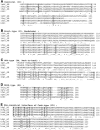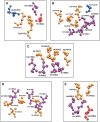Determinants of quaternary association in legume lectins
- PMID: 15215518
- PMCID: PMC2279936
- DOI: 10.1110/ps.04651004
Determinants of quaternary association in legume lectins
Abstract
It is well known that the sequence of amino acids in proteins code for its tertiary structure. It is also known that there exists a relationship between sequence and the quaternary structure of proteins. The question addressed here is whether the nature of quaternary association can be predicted from the sequence, similar to the three-dimensional structure prediction from the sequence. The class of proteins called legume lectins is an interesting model system to investigate this problem, because they have very high sequence and tertiary structure homology, with diverse forms of quaternary association. Hence, we have used legume lectins as a probe in this paper to (1) gain novel insights about the relationship between sequence and quaternary structure; (2) identify the sequence motifs that are characteristic of a given type of quaternary association; and (3) predict the quaternary association from the sequence motif.
Figures



Similar articles
-
Insights into the quaternary association of proteins through structure graphs: a case study of lectins.Biochem J. 2005 Oct 1;391(Pt 1):1-15. doi: 10.1042/BJ20050434. Biochem J. 2005. PMID: 16173917 Free PMC article. Review.
-
Weak protein-protein interactions in lectins: the crystal structure of a vegetative lectin from the legume Dolichos biflorus.J Mol Biol. 2001 May 25;309(1):193-201. doi: 10.1006/jmbi.2001.4639. J Mol Biol. 2001. PMID: 11491289
-
Crystal structure of native and Cd/Cd-substituted Dioclea guianensis seed lectin. A novel manganese-binding site and structural basis of dimer-tetramer association.J Mol Biol. 2001 Jul 20;310(4):885-94. doi: 10.1006/jmbi.2001.4814. J Mol Biol. 2001. PMID: 11453695
-
Protein structure prediction based on sequence similarity.Methods Mol Biol. 2009;569:129-56. doi: 10.1007/978-1-59745-524-4_7. Methods Mol Biol. 2009. PMID: 19623489
-
Legume lectin family, the 'natural mutants of the quaternary state', provide insights into the relationship between protein stability and oligomerization.Biochim Biophys Acta. 2001 Aug 15;1527(3):102-11. doi: 10.1016/s0304-4165(01)00153-2. Biochim Biophys Acta. 2001. PMID: 11479026 Review.
Cited by
-
Analysis and prediction of cancerlectins using evolutionary and domain information.BMC Res Notes. 2011 Jul 20;4:237. doi: 10.1186/1756-0500-4-237. BMC Res Notes. 2011. PMID: 21774797 Free PMC article.
-
Cloning, Characterization, Expression Analysis, and Agglutination Studies of Novel Gene Encoding β-D-Galactose, N-Acetyl-D-Glucosamine and Lactose-Binding Lectin from Rice Bean (Vigna umbellata).Mol Biotechnol. 2022 Mar;64(3):293-310. doi: 10.1007/s12033-021-00410-y. Epub 2021 Oct 5. Mol Biotechnol. 2022. PMID: 34611825
-
Structure predictions of two Bauhinia variegata lectins reveal patterns of C-terminal properties in single chain legume lectins.PLoS One. 2013 Nov 19;8(11):e81338. doi: 10.1371/journal.pone.0081338. eCollection 2013. PLoS One. 2013. PMID: 24260572 Free PMC article.
-
Crystallization and preliminary X-ray analysis of the Man(alpha1-2)Man-specific lectin from Bowringia mildbraedii in complex with its carbohydrate ligand.Acta Crystallogr Sect F Struct Biol Cryst Commun. 2005 Oct 1;61(Pt 10):931-4. doi: 10.1107/S174430910502854X. Epub 2005 Sep 30. Acta Crystallogr Sect F Struct Biol Cryst Commun. 2005. PMID: 16511199 Free PMC article.
-
Elucidation of the conformational free energy landscape in H.pylori LuxS and its implications to catalysis.BMC Struct Biol. 2010 Aug 12;10:27. doi: 10.1186/1472-6807-10-27. BMC Struct Biol. 2010. PMID: 20704697 Free PMC article.
References
-
- Brinda, K.V., Kannan, N., and Vishveshwara, S. 2002. Analysis of homodimeric protein interfaces by graph-spectral methods. Protein Eng. 4 265–277. - PubMed
-
- Buts, L., Dao-Thi, M.H., Loris, R., Wyns, L., Etzler, M., and Hamelryck, T. 2001. Weak protein–protein interactions in lectins: The crystal structure of a vegetative lectin from the legume Dolichos biflorus. J. Mol. Biol. 309 193–201. - PubMed
Publication types
MeSH terms
Substances
Associated data
- Actions
- Actions
- Actions
- Actions
- Actions
- Actions
LinkOut - more resources
Full Text Sources

